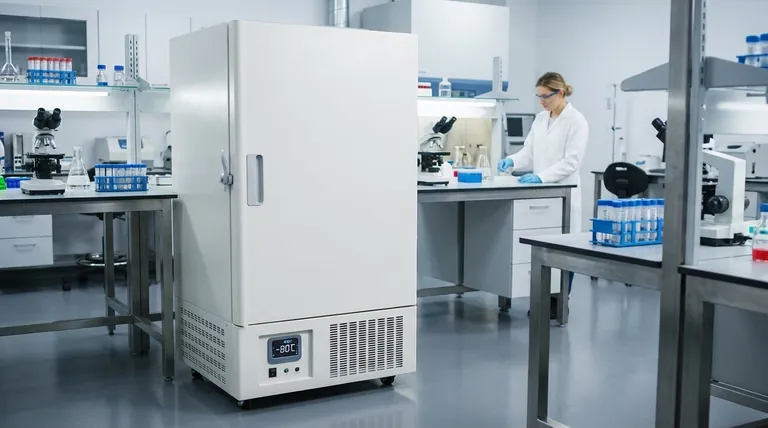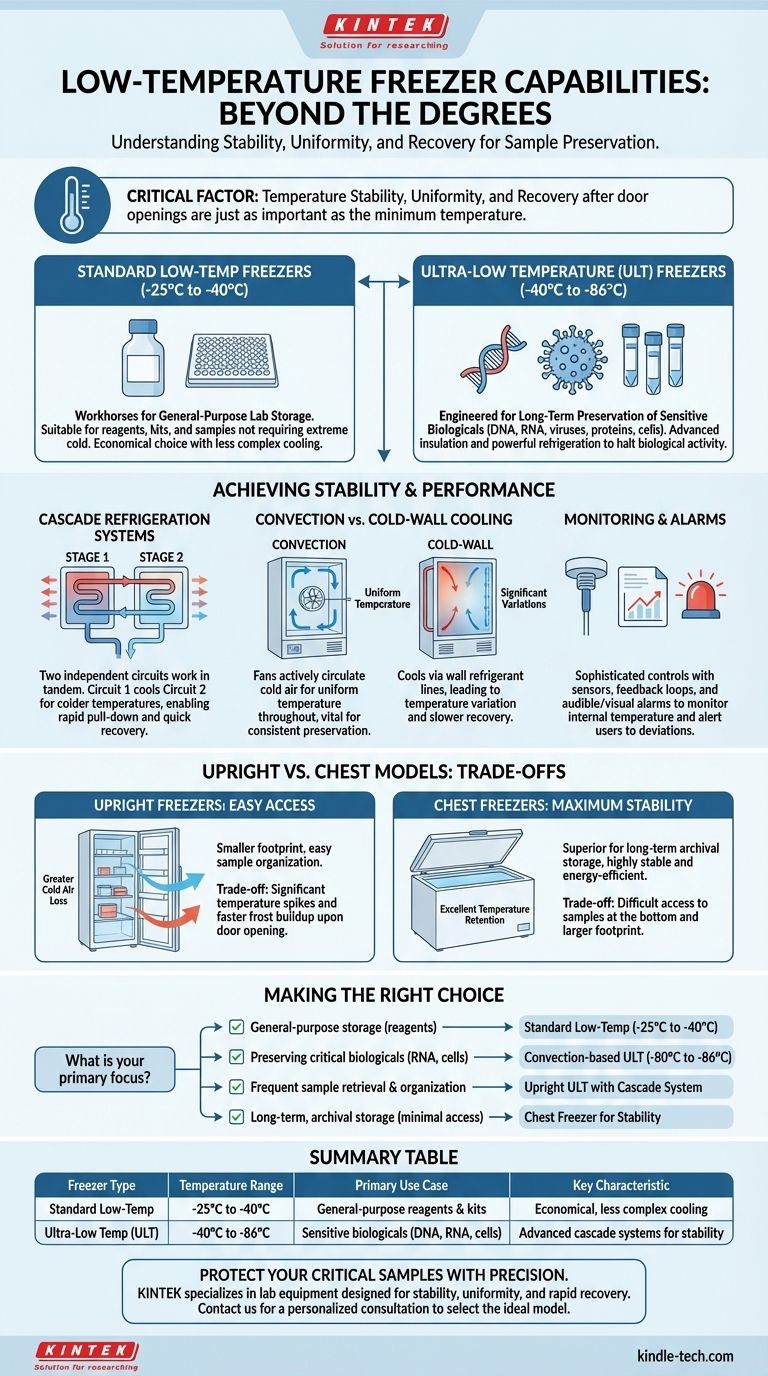At a minimum, a low-temperature freezer can maintain temperatures between -25°C and -40°C. However, the term is often used more broadly to include ultra-low temperature (ULT) freezers, which are a distinct class of equipment designed to reliably hold temperatures between -40°C and -86°C for the long-term preservation of sensitive biological materials.
The specific temperature a freezer can reach is only the starting point. The critical factor for protecting valuable samples is understanding the technology that ensures temperature stability, uniformity, and recovery after a door is opened.
The Two Classes of Low-Temperature Freezers
Your choice of freezer depends entirely on the sensitivity of the materials you need to store. The industry divides these units into two primary categories based on their operational temperature range.
Standard Low-Temperature Freezers (-25°C to -40°C)
These freezers are the workhorses for general-purpose laboratory storage. They are suitable for reagents, kits, and biological samples that do not require the extreme cold of a ULT unit.
Their cooling systems are less complex, making them a more economical choice when ultra-low temperatures are not a strict requirement for sample viability.
Ultra-Low Temperature (ULT) Freezers (-40°C to -86°C)
ULT freezers are engineered for the critical, long-term preservation of sensitive biologicals like DNA, RNA, viruses, proteins, and cell extracts. Maintaining temperatures at or below -80°C is essential to halt biological activity and prevent sample degradation over months or years.
These units feature advanced insulation, robust construction, and powerful refrigeration systems to ensure they can reliably maintain these extreme temperatures.
How Temperature Stability is Achieved and Maintained
The ability to simply reach -80°C is not enough. A high-performance ULT freezer must maintain that temperature with precision, even in a busy lab environment. This is achieved through specific engineering and design choices.
Cascade Refrigeration Systems
Most ULT freezers use a cascade refrigeration system. This involves two independent refrigeration circuits that work in tandem. The first circuit cools the second, allowing the second circuit to achieve much colder temperatures than a single system ever could.
This two-stage approach provides the power needed for both rapid temperature "pull-down" (initial cooling) and quick recovery after door openings.
Convection vs. Cold-Wall Cooling
The method of circulating cold air is a critical differentiator. Convection-based models use fans to actively circulate cold air, ensuring a highly uniform temperature throughout the entire chamber. This is vital for consistent sample preservation.
In contrast, older or more basic cold-wall freezers cool the chamber via refrigerant lines in the walls. This can create significant temperature variations within the unit and leads to much slower temperature recovery times after the door has been opened.
Monitoring and Alarms
Modern freezers are equipped with sophisticated control systems. Sensors and feedback loops constantly monitor the internal temperature and adjust the cooling system to keep it within a tight setpoint.
Audible and visual alarms are standard, immediately alerting users to any temperature deviations that could jeopardize samples.
Understanding the Trade-offs: Upright vs. Chest Models
The physical design of the freezer has a direct impact on its performance and usability.
Upright Freezers: For Easy Access
Upright models are the most common choice in labs due to their smaller footprint and the ease of organizing and accessing samples on shelves. They function like a standard refrigerator.
The major trade-off is greater cold air loss when the door is opened. Warm, moist ambient air rushes in, causing temporary temperature spikes and requiring the system to work harder to recover. This also leads to faster frost buildup.
Chest Freezers: For Maximum Stability
Chest freezers are the superior choice for long-term, archival storage where access is infrequent. Because cold air is dense, very little is lost when the lid is opened.
This design provides exceptional temperature stability and energy efficiency. However, accessing samples at the bottom can be difficult, and they require a larger floor footprint.
Making the Right Choice for Your Application
Selecting a freezer is a long-term investment in the security of your work. Match the freezer's capabilities to your specific storage needs.
- If your primary focus is general-purpose storage of less sensitive reagents: A standard low-temperature freezer (-25°C to -40°C) is often sufficient and more cost-effective.
- If your primary focus is preserving critical biological samples (e.g., RNA, cell lines): A convection-based ULT freezer capable of reaching and holding -80°C to -86°C is non-negotiable.
- If your primary focus is frequent sample retrieval and organization: An upright ULT model with a powerful cascade refrigeration system is the best choice for balancing access with performance.
- If your primary focus is long-term, archival storage with minimal access: A chest freezer offers the most stable and energy-efficient environment to protect samples for years.
By looking beyond the temperature specification to the underlying technology, you can confidently select a freezer that actively protects your most valuable assets.

Summary Table:
| Freezer Type | Temperature Range | Primary Use Case | Key Characteristic |
|---|---|---|---|
| Standard Low-Temp | -25°C to -40°C | General-purpose reagents and kits | Economical, less complex cooling |
| Ultra-Low Temp (ULT) | -40°C to -86°C | Sensitive biologicals (DNA, RNA, cells) | Advanced cascade systems for stability |
Protect your critical samples with precision. The right low-temperature freezer is a long-term investment in your research integrity. KINTEK specializes in lab equipment, offering a range of reliable freezers designed for stability, uniformity, and rapid temperature recovery. Let our experts help you select the ideal model for your specific samples and workflow. Contact KINTEK today for a personalized consultation!
Visual Guide

Related Products
- 608L Essential Laboratory Ultra Low Temperature Freezer For Critical Sample Preservation
- 208L Advanced Precision Laboratory Ultra Low Temperature Freezer for Cold Storage
- 158L Precision Vertical Ultra Low Freezer for Laboratory Applications
- 408L Advanced Vertical Laboratory Ultra Low Temperature Freezer for Critical Research Material Preservation
- 508L Advanced Vertical Ultra Low Temperature Freezer for Critical Laboratory Storage
People Also Ask
- What advantages do ultra-low temperature freezers offer? Ensure Long-Term Sample Integrity and Reliability
- What makes Ultra-Low Temperature freezers energy efficient? Key Design & Operational Strategies
- What is an ultra-low temperature freezer? Protect Your Most Valuable Biological Samples
- In what fields are ultra low temperature freezers most commonly used? Essential for Biomedical, Clinical, and Research Labs
- What factors should be considered when selecting an ultra-low temperature freezer? Ensure Sample Integrity and Long-Term Value



















